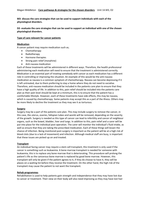Megan Middleton Care pathways & strategies for the chosen disorders Unit 14.M3, D2
M3- discuss the care strategies that can be used to support individuals with each of the
physiological disorders.
D2- evaluate the care strategies that can be used to support an individual with one of the chosen
physiological disorders.
Type of care relevant for cancer patients
Medication
A cancer patient may require medication such as;
Chemotherapy
Radiotherapy
Hormone therapies
Strong pain relief (morphine)
Anti-nausea medication
Each of these treatments will be administered in different ways. Therefore, the health professional
administering each medication will need to ensure that the treatment is administered correctly.
Medication is an essential part of treating somebody with cancer as each medication has a different
role in controlling or improving the situation. An example of this would be the anti-nausea
medication as nausea is a common symptom of chemotherapy. Nausea can become depressing if it
is left untreated, due to them preferring to stay a home where they do not need to socialise.
Therefore, anti-nausea medication should be included in the patients care plan to ensure that they
have a high quality of life. In addition to this, pain relief should be included into the patients care
plan as their pain level should be kept at a minimum, this is to ensure that the patient has a
comfortable lifestyle. However, each of these treatments have side effects, this may be nausea,
which is caused by chemotherapy. Some patients may accept this as a part of the illness. Others may
be more likely to decline the treatment as they may see it as torturous.
Surgery
Surgery may be a part of the patients care plan. This may include surgery to remove the cancer, in
this case, the uterus, ovaries, fallopian tubes and womb will be removed, depending on the severity
of the growth. Surgery is needed as this type of cancer can lead to infertility and cancer of neighbour
organs, such as the bowel, bladder, liver and lungs. In addition to this, pain relief and a carer will be
put into place for the individual post operation. The carer will monitor the individual’s fluid intake, as
well as ensure that they are taking the prescribed medication. Each of these things will lessen the
chance of infection. Being monitored post-surgery is important as the patient will be at a high risk of
blood clots (due to a lack of movement) and infection. Although medical staff are busy, is important
that these issues are picked up on and treated.
Transplant
An individual facing cancer may require a stem cell transplant, this treatment is only used if the
cancer is something such as leukaemia. A bone marrow transplant is needed for someone with
leukaemia, this is to replace any bone marrow that is deteriorating. This procedure will prolong the
patient’s life as the cancerous bone marrow is replaced by good bone marrow. However, this
transplant will only be given if the patient agrees to it, if they do choose to have it, they will be
places on a waiting list before they receive the treatment. On the other hand, the high risk of the
transplant may cause the patient to not want the transplant.
Rehab programmes
Rehabilitation is used to help patients gain strength and independence that they may have lost due
to cancer or treatment. Their view on their body will also need improving as they may have lost hair




